Intercultural Communication Report: Business Expansion in China
VerifiedAdded on 2020/02/18
|11
|2219
|134
Report
AI Summary
This report examines intercultural communication within the context of business expansion, specifically focusing on the challenges and solutions faced by the Yabbies R Us firm in China. The report delves into the diversity of Chinese culture and its impact on communication styles, emphasizing the importance of understanding cultural nuances to avoid ambiguity and foster effective communication. It highlights the need for flexible attitudes and an understanding of cultural values, drawing upon Hofstede's cultural dimensions. The report recommends that the firm's management adapt to the Chinese cultural context, avoid ethnocentrism, and demonstrate a willingness to learn from and respect Chinese perspectives. The conclusion stresses the importance of intercultural communication for successful business growth in a globalized world, emphasizing the need for awareness of cultural sensitivities and the adoption of appropriate communication strategies.
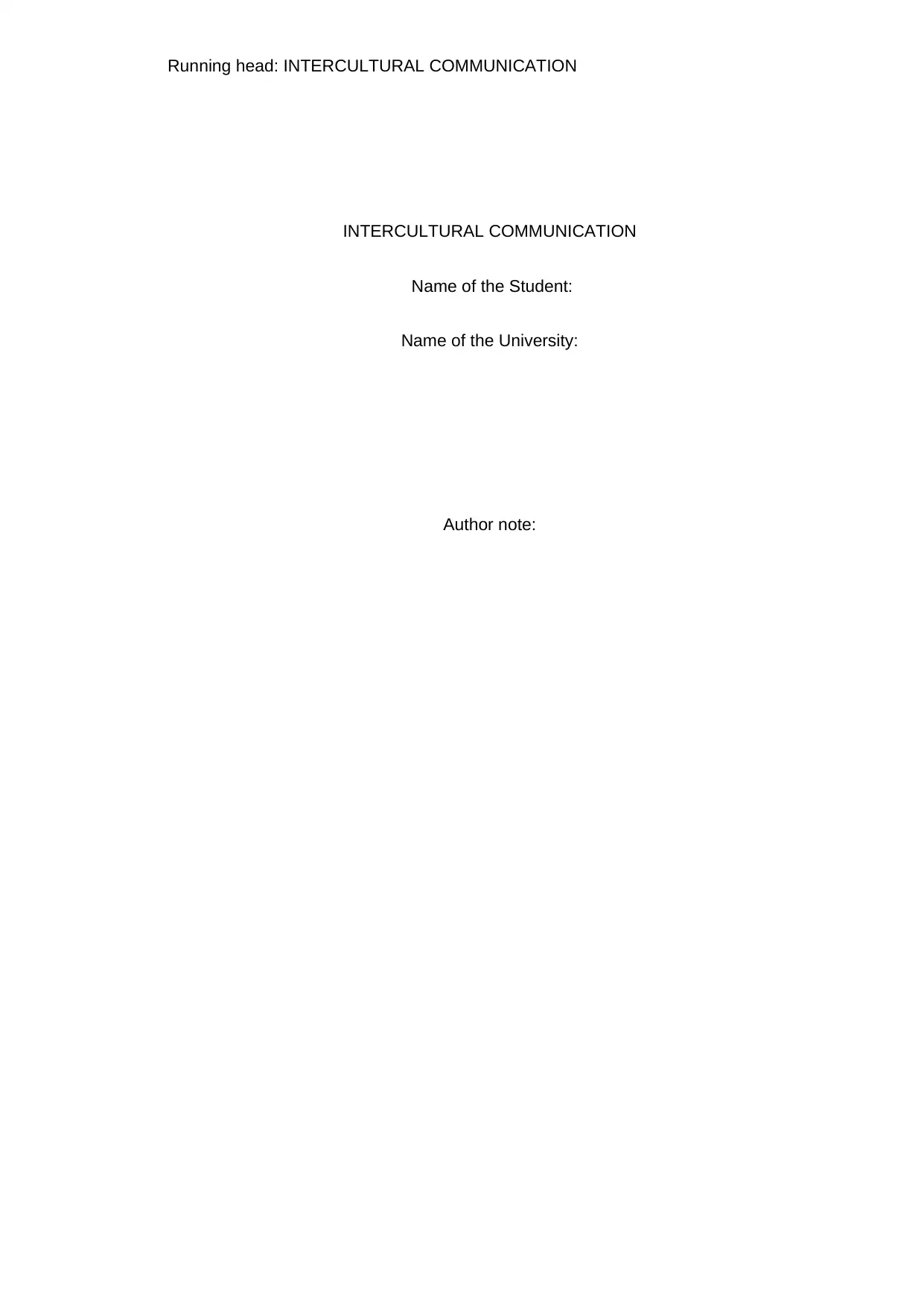
Running head: INTERCULTURAL COMMUNICATION
INTERCULTURAL COMMUNICATION
Name of the Student:
Name of the University:
Author note:
INTERCULTURAL COMMUNICATION
Name of the Student:
Name of the University:
Author note:
Paraphrase This Document
Need a fresh take? Get an instant paraphrase of this document with our AI Paraphraser
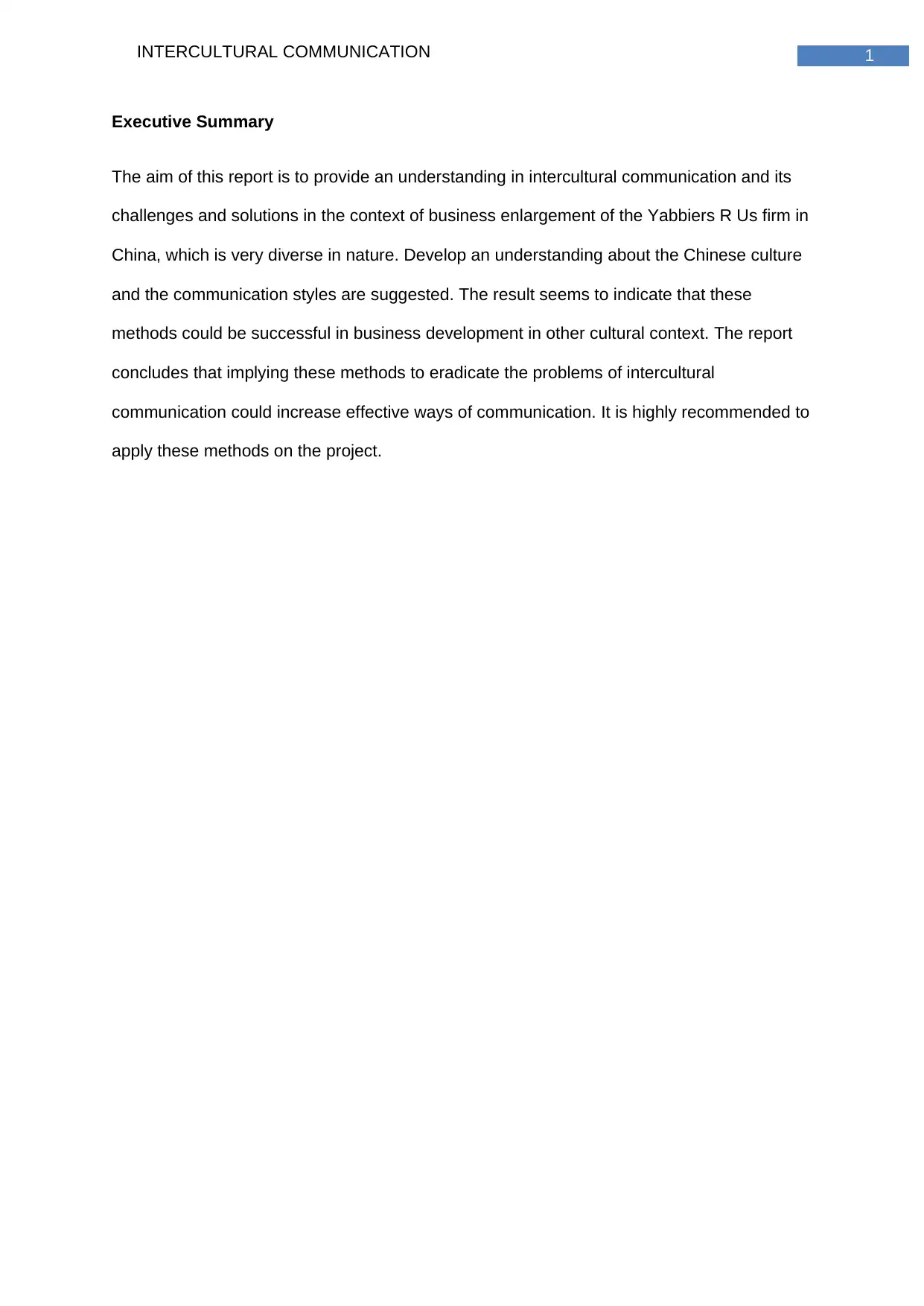
1INTERCULTURAL COMMUNICATION
Executive Summary
The aim of this report is to provide an understanding in intercultural communication and its
challenges and solutions in the context of business enlargement of the Yabbiers R Us firm in
China, which is very diverse in nature. Develop an understanding about the Chinese culture
and the communication styles are suggested. The result seems to indicate that these
methods could be successful in business development in other cultural context. The report
concludes that implying these methods to eradicate the problems of intercultural
communication could increase effective ways of communication. It is highly recommended to
apply these methods on the project.
Executive Summary
The aim of this report is to provide an understanding in intercultural communication and its
challenges and solutions in the context of business enlargement of the Yabbiers R Us firm in
China, which is very diverse in nature. Develop an understanding about the Chinese culture
and the communication styles are suggested. The result seems to indicate that these
methods could be successful in business development in other cultural context. The report
concludes that implying these methods to eradicate the problems of intercultural
communication could increase effective ways of communication. It is highly recommended to
apply these methods on the project.

2INTERCULTURAL COMMUNICATION
Table of Contents
Introduction...........................................................................................................................................3
Discussions............................................................................................................................................3
Diversity of China...............................................................................................................................3
Yabbies R Us Firm..............................................................................................................................5
Challenges and solution of Intercultural Communication..................................................................5
Ambiguity and Develop an understandings about the ways others communicate............................6
Recommendation..............................................................................................................................6
Inflexible Attitudes and understanding the values of the culture......................................................6
Recommendation..............................................................................................................................7
Conclusion.............................................................................................................................................7
References.............................................................................................................................................9
Table of Contents
Introduction...........................................................................................................................................3
Discussions............................................................................................................................................3
Diversity of China...............................................................................................................................3
Yabbies R Us Firm..............................................................................................................................5
Challenges and solution of Intercultural Communication..................................................................5
Ambiguity and Develop an understandings about the ways others communicate............................6
Recommendation..............................................................................................................................6
Inflexible Attitudes and understanding the values of the culture......................................................6
Recommendation..............................................................................................................................7
Conclusion.............................................................................................................................................7
References.............................................................................................................................................9
⊘ This is a preview!⊘
Do you want full access?
Subscribe today to unlock all pages.

Trusted by 1+ million students worldwide
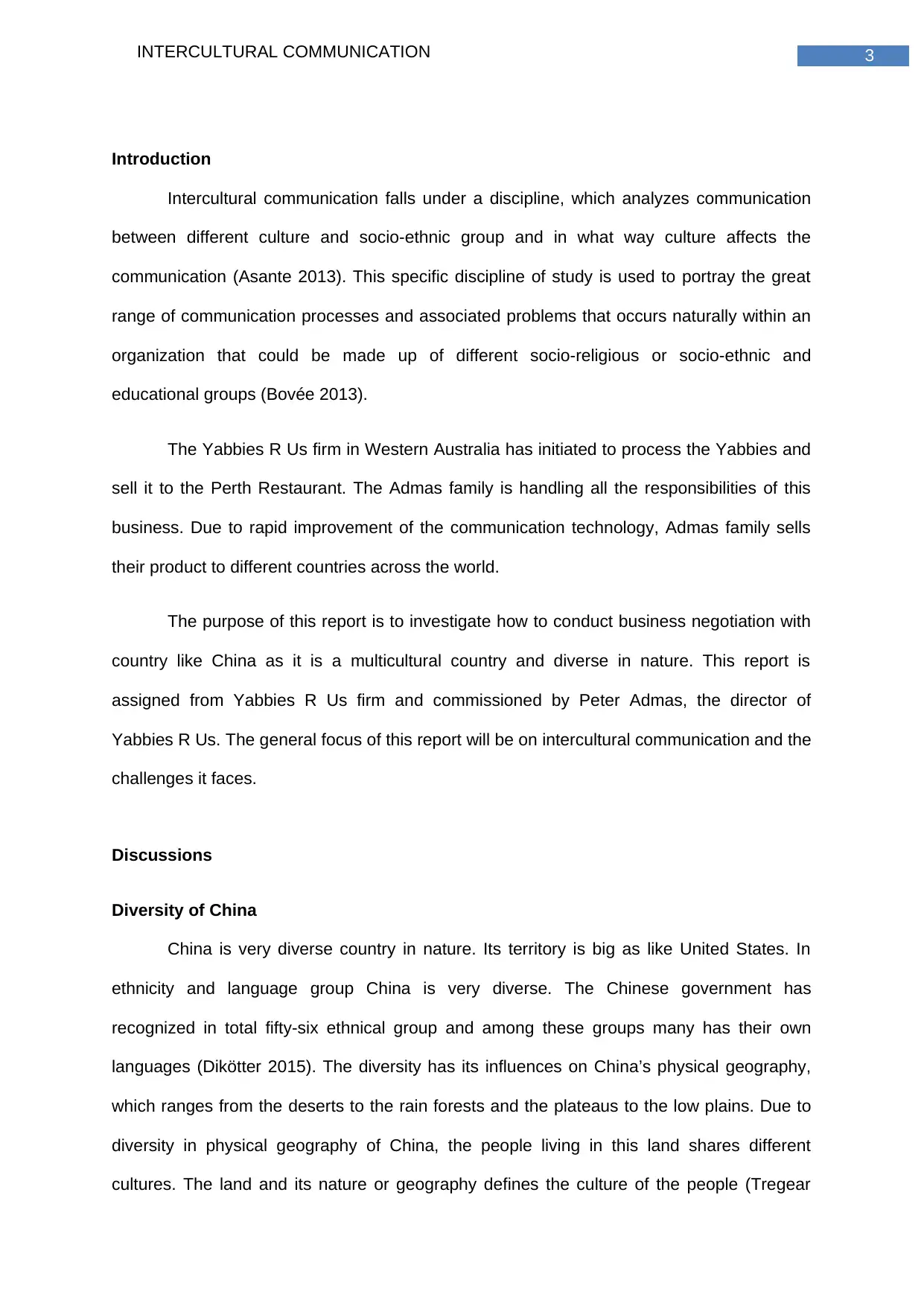
3INTERCULTURAL COMMUNICATION
Introduction
Intercultural communication falls under a discipline, which analyzes communication
between different culture and socio-ethnic group and in what way culture affects the
communication (Asante 2013). This specific discipline of study is used to portray the great
range of communication processes and associated problems that occurs naturally within an
organization that could be made up of different socio-religious or socio-ethnic and
educational groups (Bovée 2013).
The Yabbies R Us firm in Western Australia has initiated to process the Yabbies and
sell it to the Perth Restaurant. The Admas family is handling all the responsibilities of this
business. Due to rapid improvement of the communication technology, Admas family sells
their product to different countries across the world.
The purpose of this report is to investigate how to conduct business negotiation with
country like China as it is a multicultural country and diverse in nature. This report is
assigned from Yabbies R Us firm and commissioned by Peter Admas, the director of
Yabbies R Us. The general focus of this report will be on intercultural communication and the
challenges it faces.
Discussions
Diversity of China
China is very diverse country in nature. Its territory is big as like United States. In
ethnicity and language group China is very diverse. The Chinese government has
recognized in total fifty-six ethnical group and among these groups many has their own
languages (Dikötter 2015). The diversity has its influences on China’s physical geography,
which ranges from the deserts to the rain forests and the plateaus to the low plains. Due to
diversity in physical geography of China, the people living in this land shares different
cultures. The land and its nature or geography defines the culture of the people (Tregear
Introduction
Intercultural communication falls under a discipline, which analyzes communication
between different culture and socio-ethnic group and in what way culture affects the
communication (Asante 2013). This specific discipline of study is used to portray the great
range of communication processes and associated problems that occurs naturally within an
organization that could be made up of different socio-religious or socio-ethnic and
educational groups (Bovée 2013).
The Yabbies R Us firm in Western Australia has initiated to process the Yabbies and
sell it to the Perth Restaurant. The Admas family is handling all the responsibilities of this
business. Due to rapid improvement of the communication technology, Admas family sells
their product to different countries across the world.
The purpose of this report is to investigate how to conduct business negotiation with
country like China as it is a multicultural country and diverse in nature. This report is
assigned from Yabbies R Us firm and commissioned by Peter Admas, the director of
Yabbies R Us. The general focus of this report will be on intercultural communication and the
challenges it faces.
Discussions
Diversity of China
China is very diverse country in nature. Its territory is big as like United States. In
ethnicity and language group China is very diverse. The Chinese government has
recognized in total fifty-six ethnical group and among these groups many has their own
languages (Dikötter 2015). The diversity has its influences on China’s physical geography,
which ranges from the deserts to the rain forests and the plateaus to the low plains. Due to
diversity in physical geography of China, the people living in this land shares different
cultures. The land and its nature or geography defines the culture of the people (Tregear
Paraphrase This Document
Need a fresh take? Get an instant paraphrase of this document with our AI Paraphraser

4INTERCULTURAL COMMUNICATION
2017). For an example, the people living near the sea have cultures developed from its
geography, differ from other culture, and place like Tibetan Plateau. There is no official
religion defined by the government, however, people practices Christianity, Buddhism, Islam,
Taoism and Judaism in China.
The different ethnical group and their individual lifestyles and cultures include Han
ethnicity, Manchus ethnicity, which has their own languages, lifestyle, dressing style,
surnames, sports and other minor ethnical groups. The majority of the Islamic population
lives in Northwestern China. The two major ethnical groups in this region is Uyghurs and
Hui. The highest place in the world, the Tibetan plateau has two major ethnic groups such as
Tibetans and Qiang, they practices their own religion called Bon (Eberhard 2013). However,
in China proper the major practiced religion is Buddhism. Architectures arts, literature, even
music and regular lives of the dwellers on the plateau in China proper are very closely
related to Buddhism.
The most diversified place of China is Southwestern China. There are in total around
30 native ethnical groups in Guangxi Yunnan and Guizhou. Their languages, dressings and
lifestyles, music and food differ from each other’s. Most of these ethnic groups have many
branches with completely different characteristics (Mason 2014).
Apart from the different ethnical groups in china, the authentic Chinese food can be
categorized based on how cooking can be done and what is there to eat. There are different
styles of Chinese food with many subdivision of it.
However, china is diverse in terms of culture, religion, people, lifestyles, music,
cooking style, sports, dressing style and administrative nature. Hong Kong and Macue follow
different administrative style differ from mainland China. These two countries have different
laws and administrative systems (Hua and Nathan 2016). For example, the Google, Twitter
and other social media application are allowed in the regions where other parts do not have
access to use it. The diversity in China allows this country to live its citizen as cooperative as
2017). For an example, the people living near the sea have cultures developed from its
geography, differ from other culture, and place like Tibetan Plateau. There is no official
religion defined by the government, however, people practices Christianity, Buddhism, Islam,
Taoism and Judaism in China.
The different ethnical group and their individual lifestyles and cultures include Han
ethnicity, Manchus ethnicity, which has their own languages, lifestyle, dressing style,
surnames, sports and other minor ethnical groups. The majority of the Islamic population
lives in Northwestern China. The two major ethnical groups in this region is Uyghurs and
Hui. The highest place in the world, the Tibetan plateau has two major ethnic groups such as
Tibetans and Qiang, they practices their own religion called Bon (Eberhard 2013). However,
in China proper the major practiced religion is Buddhism. Architectures arts, literature, even
music and regular lives of the dwellers on the plateau in China proper are very closely
related to Buddhism.
The most diversified place of China is Southwestern China. There are in total around
30 native ethnical groups in Guangxi Yunnan and Guizhou. Their languages, dressings and
lifestyles, music and food differ from each other’s. Most of these ethnic groups have many
branches with completely different characteristics (Mason 2014).
Apart from the different ethnical groups in china, the authentic Chinese food can be
categorized based on how cooking can be done and what is there to eat. There are different
styles of Chinese food with many subdivision of it.
However, china is diverse in terms of culture, religion, people, lifestyles, music,
cooking style, sports, dressing style and administrative nature. Hong Kong and Macue follow
different administrative style differ from mainland China. These two countries have different
laws and administrative systems (Hua and Nathan 2016). For example, the Google, Twitter
and other social media application are allowed in the regions where other parts do not have
access to use it. The diversity in China allows this country to live its citizen as cooperative as
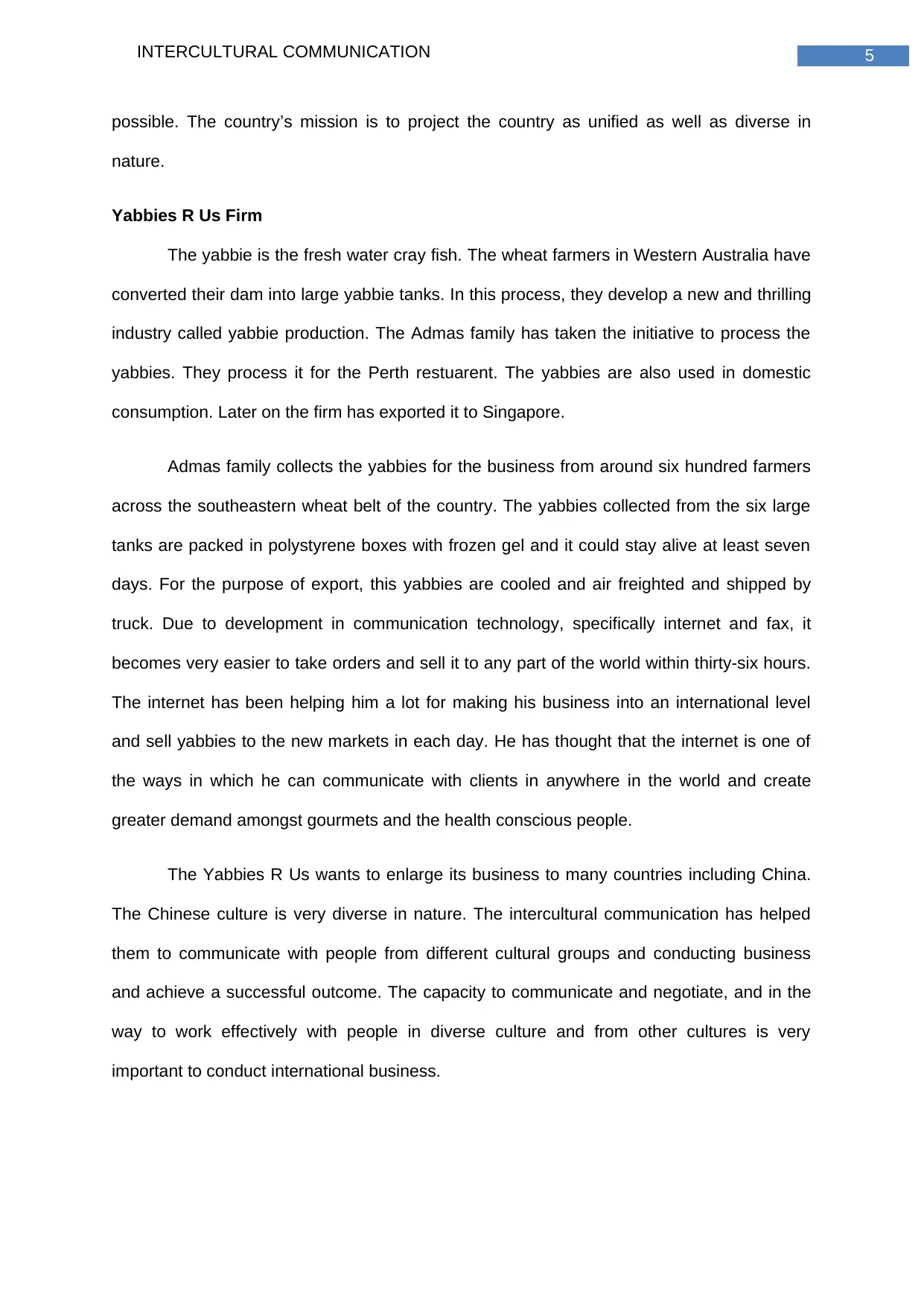
5INTERCULTURAL COMMUNICATION
possible. The country’s mission is to project the country as unified as well as diverse in
nature.
Yabbies R Us Firm
The yabbie is the fresh water cray fish. The wheat farmers in Western Australia have
converted their dam into large yabbie tanks. In this process, they develop a new and thrilling
industry called yabbie production. The Admas family has taken the initiative to process the
yabbies. They process it for the Perth restuarent. The yabbies are also used in domestic
consumption. Later on the firm has exported it to Singapore.
Admas family collects the yabbies for the business from around six hundred farmers
across the southeastern wheat belt of the country. The yabbies collected from the six large
tanks are packed in polystyrene boxes with frozen gel and it could stay alive at least seven
days. For the purpose of export, this yabbies are cooled and air freighted and shipped by
truck. Due to development in communication technology, specifically internet and fax, it
becomes very easier to take orders and sell it to any part of the world within thirty-six hours.
The internet has been helping him a lot for making his business into an international level
and sell yabbies to the new markets in each day. He has thought that the internet is one of
the ways in which he can communicate with clients in anywhere in the world and create
greater demand amongst gourmets and the health conscious people.
The Yabbies R Us wants to enlarge its business to many countries including China.
The Chinese culture is very diverse in nature. The intercultural communication has helped
them to communicate with people from different cultural groups and conducting business
and achieve a successful outcome. The capacity to communicate and negotiate, and in the
way to work effectively with people in diverse culture and from other cultures is very
important to conduct international business.
possible. The country’s mission is to project the country as unified as well as diverse in
nature.
Yabbies R Us Firm
The yabbie is the fresh water cray fish. The wheat farmers in Western Australia have
converted their dam into large yabbie tanks. In this process, they develop a new and thrilling
industry called yabbie production. The Admas family has taken the initiative to process the
yabbies. They process it for the Perth restuarent. The yabbies are also used in domestic
consumption. Later on the firm has exported it to Singapore.
Admas family collects the yabbies for the business from around six hundred farmers
across the southeastern wheat belt of the country. The yabbies collected from the six large
tanks are packed in polystyrene boxes with frozen gel and it could stay alive at least seven
days. For the purpose of export, this yabbies are cooled and air freighted and shipped by
truck. Due to development in communication technology, specifically internet and fax, it
becomes very easier to take orders and sell it to any part of the world within thirty-six hours.
The internet has been helping him a lot for making his business into an international level
and sell yabbies to the new markets in each day. He has thought that the internet is one of
the ways in which he can communicate with clients in anywhere in the world and create
greater demand amongst gourmets and the health conscious people.
The Yabbies R Us wants to enlarge its business to many countries including China.
The Chinese culture is very diverse in nature. The intercultural communication has helped
them to communicate with people from different cultural groups and conducting business
and achieve a successful outcome. The capacity to communicate and negotiate, and in the
way to work effectively with people in diverse culture and from other cultures is very
important to conduct international business.
⊘ This is a preview!⊘
Do you want full access?
Subscribe today to unlock all pages.

Trusted by 1+ million students worldwide
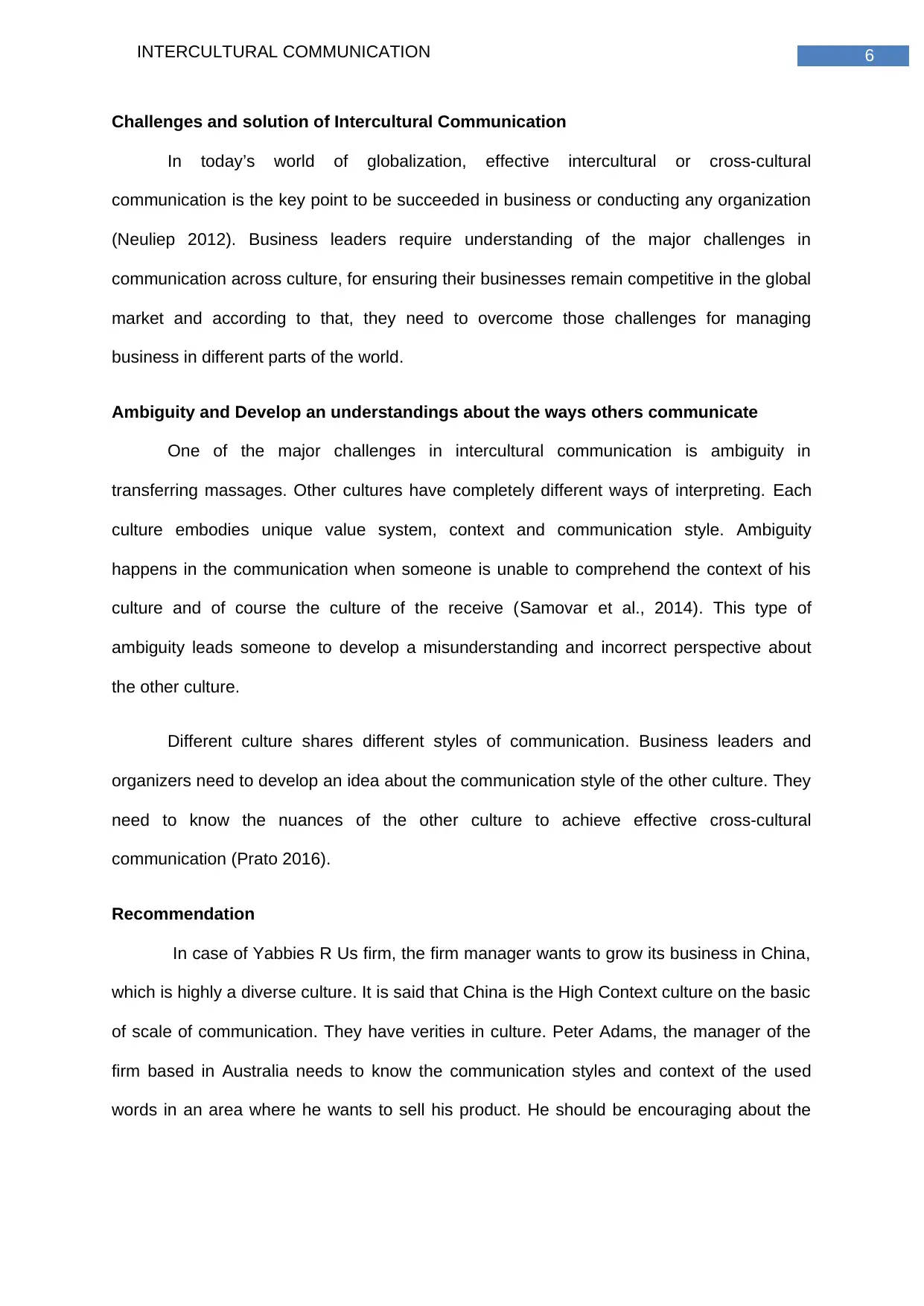
6INTERCULTURAL COMMUNICATION
Challenges and solution of Intercultural Communication
In today’s world of globalization, effective intercultural or cross-cultural
communication is the key point to be succeeded in business or conducting any organization
(Neuliep 2012). Business leaders require understanding of the major challenges in
communication across culture, for ensuring their businesses remain competitive in the global
market and according to that, they need to overcome those challenges for managing
business in different parts of the world.
Ambiguity and Develop an understandings about the ways others communicate
One of the major challenges in intercultural communication is ambiguity in
transferring massages. Other cultures have completely different ways of interpreting. Each
culture embodies unique value system, context and communication style. Ambiguity
happens in the communication when someone is unable to comprehend the context of his
culture and of course the culture of the receive (Samovar et al., 2014). This type of
ambiguity leads someone to develop a misunderstanding and incorrect perspective about
the other culture.
Different culture shares different styles of communication. Business leaders and
organizers need to develop an idea about the communication style of the other culture. They
need to know the nuances of the other culture to achieve effective cross-cultural
communication (Prato 2016).
Recommendation
In case of Yabbies R Us firm, the firm manager wants to grow its business in China,
which is highly a diverse culture. It is said that China is the High Context culture on the basic
of scale of communication. They have verities in culture. Peter Adams, the manager of the
firm based in Australia needs to know the communication styles and context of the used
words in an area where he wants to sell his product. He should be encouraging about the
Challenges and solution of Intercultural Communication
In today’s world of globalization, effective intercultural or cross-cultural
communication is the key point to be succeeded in business or conducting any organization
(Neuliep 2012). Business leaders require understanding of the major challenges in
communication across culture, for ensuring their businesses remain competitive in the global
market and according to that, they need to overcome those challenges for managing
business in different parts of the world.
Ambiguity and Develop an understandings about the ways others communicate
One of the major challenges in intercultural communication is ambiguity in
transferring massages. Other cultures have completely different ways of interpreting. Each
culture embodies unique value system, context and communication style. Ambiguity
happens in the communication when someone is unable to comprehend the context of his
culture and of course the culture of the receive (Samovar et al., 2014). This type of
ambiguity leads someone to develop a misunderstanding and incorrect perspective about
the other culture.
Different culture shares different styles of communication. Business leaders and
organizers need to develop an idea about the communication style of the other culture. They
need to know the nuances of the other culture to achieve effective cross-cultural
communication (Prato 2016).
Recommendation
In case of Yabbies R Us firm, the firm manager wants to grow its business in China,
which is highly a diverse culture. It is said that China is the High Context culture on the basic
of scale of communication. They have verities in culture. Peter Adams, the manager of the
firm based in Australia needs to know the communication styles and context of the used
words in an area where he wants to sell his product. He should be encouraging about the
Paraphrase This Document
Need a fresh take? Get an instant paraphrase of this document with our AI Paraphraser
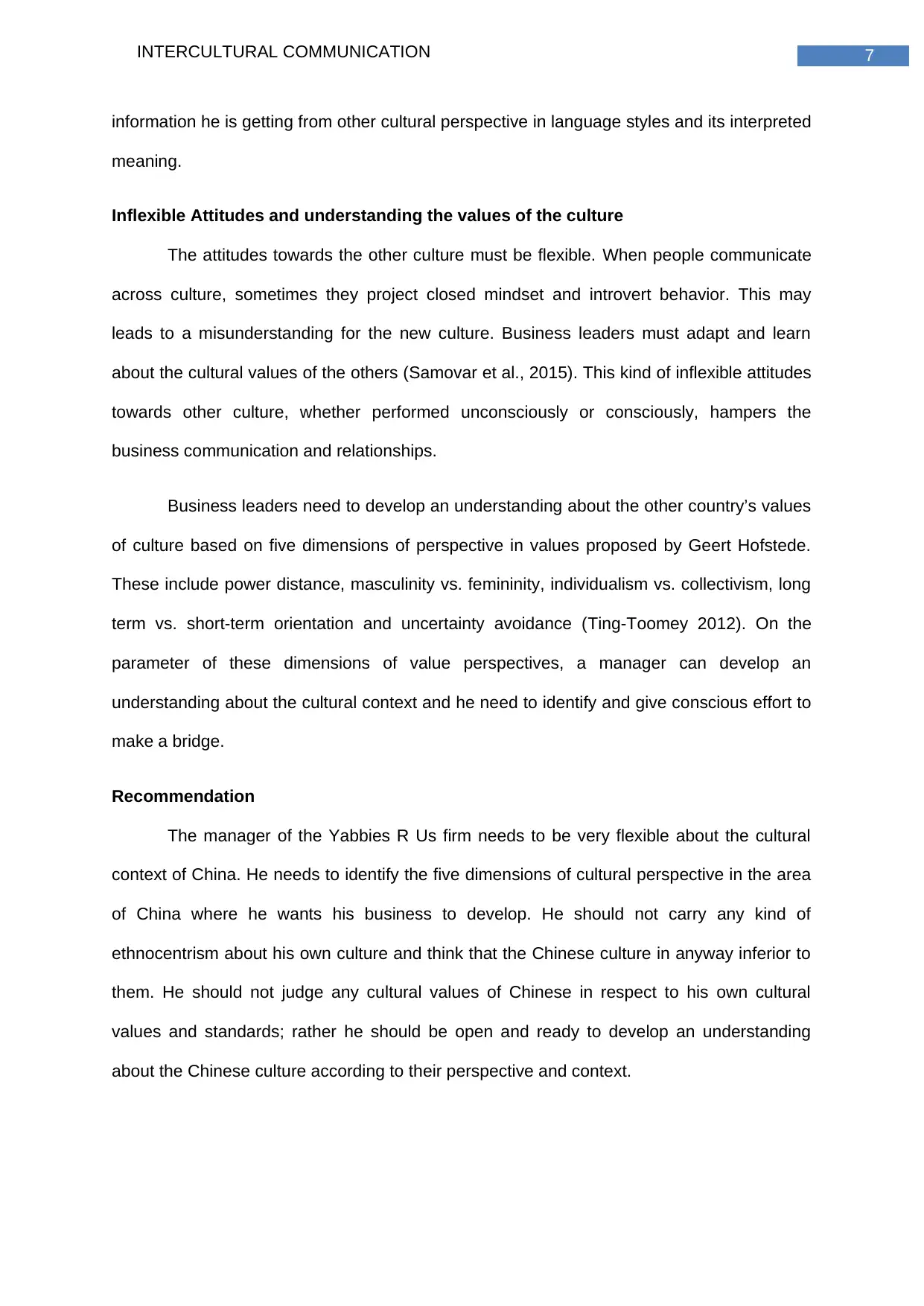
7INTERCULTURAL COMMUNICATION
information he is getting from other cultural perspective in language styles and its interpreted
meaning.
Inflexible Attitudes and understanding the values of the culture
The attitudes towards the other culture must be flexible. When people communicate
across culture, sometimes they project closed mindset and introvert behavior. This may
leads to a misunderstanding for the new culture. Business leaders must adapt and learn
about the cultural values of the others (Samovar et al., 2015). This kind of inflexible attitudes
towards other culture, whether performed unconsciously or consciously, hampers the
business communication and relationships.
Business leaders need to develop an understanding about the other country’s values
of culture based on five dimensions of perspective in values proposed by Geert Hofstede.
These include power distance, masculinity vs. femininity, individualism vs. collectivism, long
term vs. short-term orientation and uncertainty avoidance (Ting-Toomey 2012). On the
parameter of these dimensions of value perspectives, a manager can develop an
understanding about the cultural context and he need to identify and give conscious effort to
make a bridge.
Recommendation
The manager of the Yabbies R Us firm needs to be very flexible about the cultural
context of China. He needs to identify the five dimensions of cultural perspective in the area
of China where he wants his business to develop. He should not carry any kind of
ethnocentrism about his own culture and think that the Chinese culture in anyway inferior to
them. He should not judge any cultural values of Chinese in respect to his own cultural
values and standards; rather he should be open and ready to develop an understanding
about the Chinese culture according to their perspective and context.
information he is getting from other cultural perspective in language styles and its interpreted
meaning.
Inflexible Attitudes and understanding the values of the culture
The attitudes towards the other culture must be flexible. When people communicate
across culture, sometimes they project closed mindset and introvert behavior. This may
leads to a misunderstanding for the new culture. Business leaders must adapt and learn
about the cultural values of the others (Samovar et al., 2015). This kind of inflexible attitudes
towards other culture, whether performed unconsciously or consciously, hampers the
business communication and relationships.
Business leaders need to develop an understanding about the other country’s values
of culture based on five dimensions of perspective in values proposed by Geert Hofstede.
These include power distance, masculinity vs. femininity, individualism vs. collectivism, long
term vs. short-term orientation and uncertainty avoidance (Ting-Toomey 2012). On the
parameter of these dimensions of value perspectives, a manager can develop an
understanding about the cultural context and he need to identify and give conscious effort to
make a bridge.
Recommendation
The manager of the Yabbies R Us firm needs to be very flexible about the cultural
context of China. He needs to identify the five dimensions of cultural perspective in the area
of China where he wants his business to develop. He should not carry any kind of
ethnocentrism about his own culture and think that the Chinese culture in anyway inferior to
them. He should not judge any cultural values of Chinese in respect to his own cultural
values and standards; rather he should be open and ready to develop an understanding
about the Chinese culture according to their perspective and context.
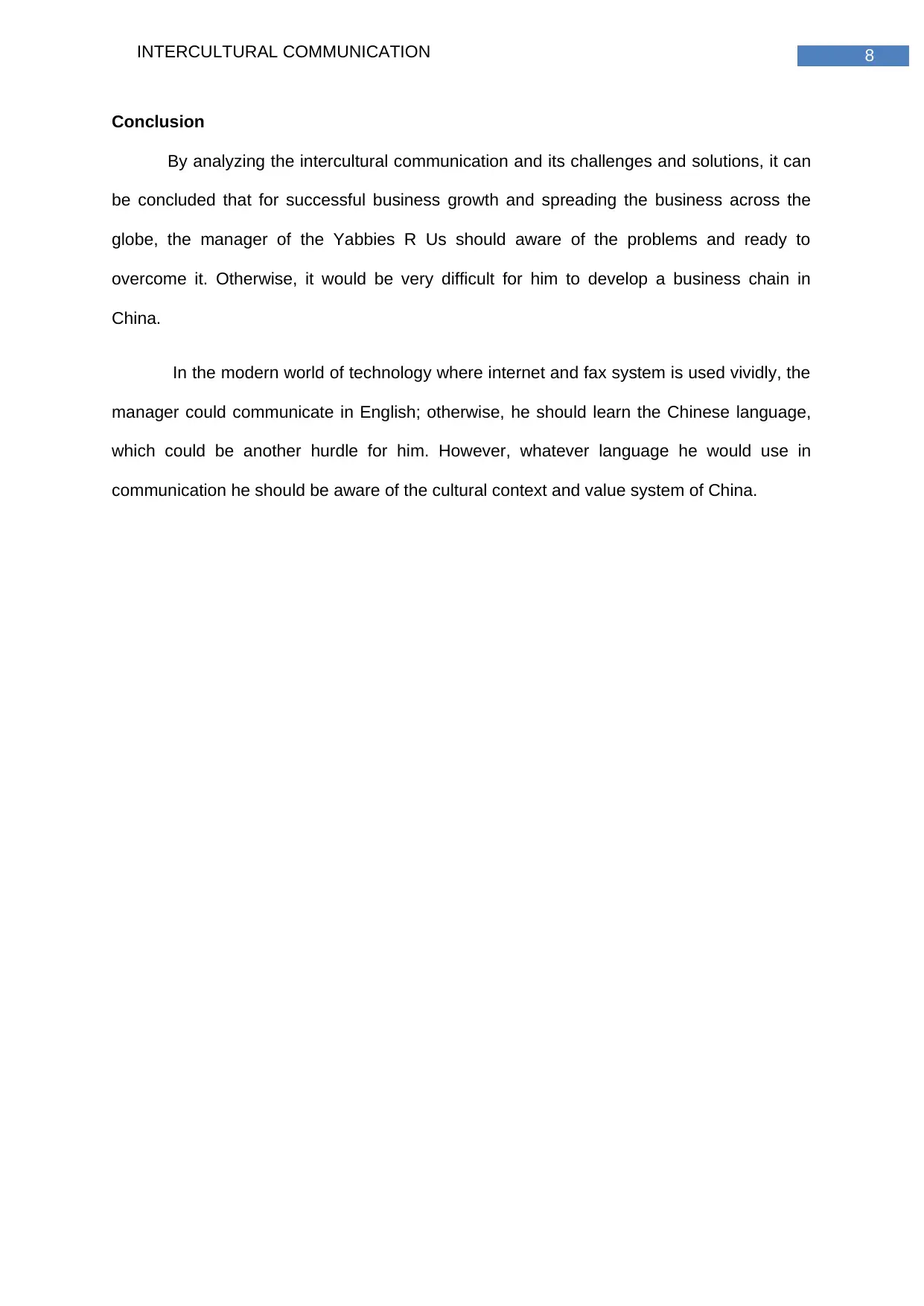
8INTERCULTURAL COMMUNICATION
Conclusion
By analyzing the intercultural communication and its challenges and solutions, it can
be concluded that for successful business growth and spreading the business across the
globe, the manager of the Yabbies R Us should aware of the problems and ready to
overcome it. Otherwise, it would be very difficult for him to develop a business chain in
China.
In the modern world of technology where internet and fax system is used vividly, the
manager could communicate in English; otherwise, he should learn the Chinese language,
which could be another hurdle for him. However, whatever language he would use in
communication he should be aware of the cultural context and value system of China.
Conclusion
By analyzing the intercultural communication and its challenges and solutions, it can
be concluded that for successful business growth and spreading the business across the
globe, the manager of the Yabbies R Us should aware of the problems and ready to
overcome it. Otherwise, it would be very difficult for him to develop a business chain in
China.
In the modern world of technology where internet and fax system is used vividly, the
manager could communicate in English; otherwise, he should learn the Chinese language,
which could be another hurdle for him. However, whatever language he would use in
communication he should be aware of the cultural context and value system of China.
⊘ This is a preview!⊘
Do you want full access?
Subscribe today to unlock all pages.

Trusted by 1+ million students worldwide
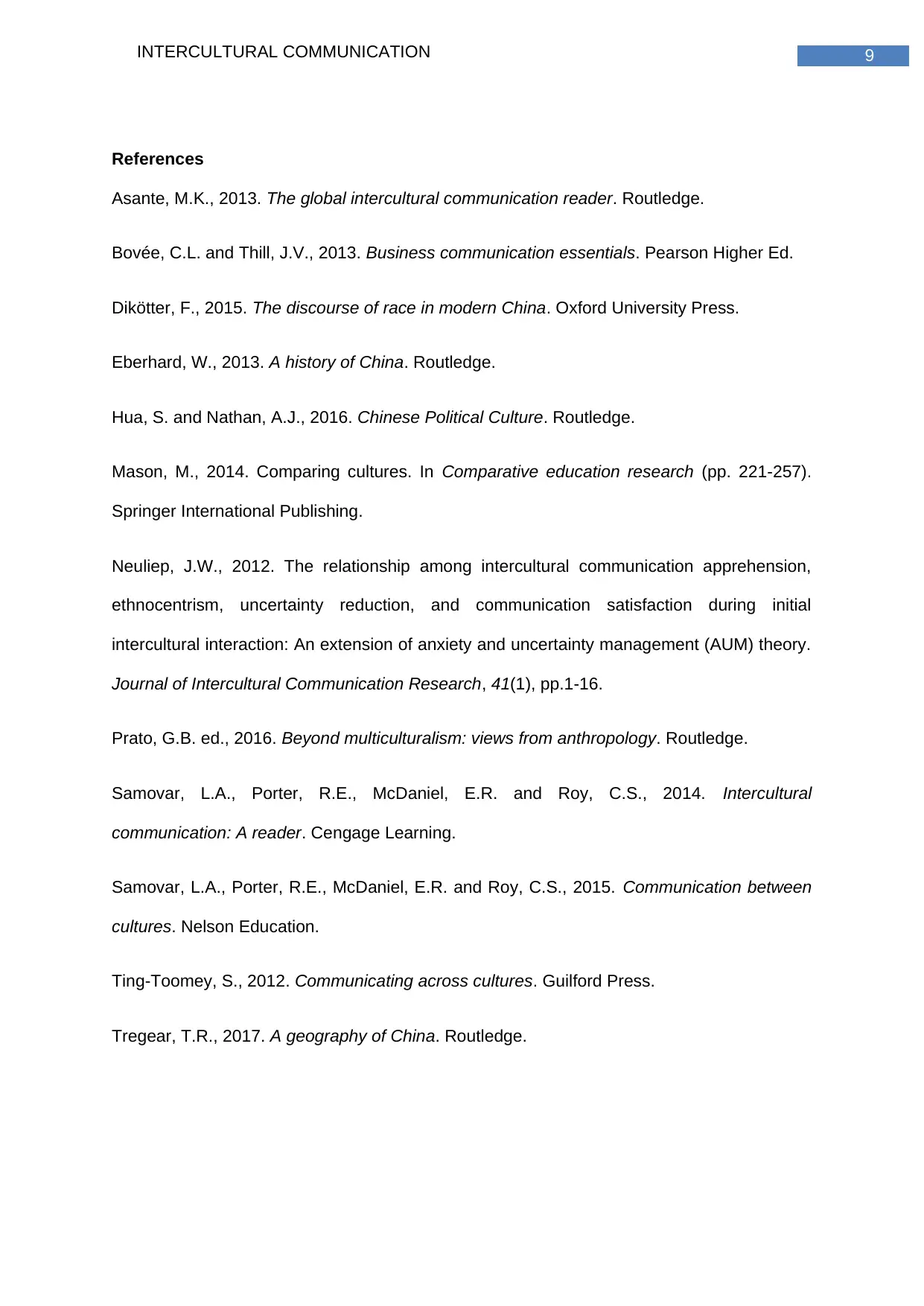
9INTERCULTURAL COMMUNICATION
References
Asante, M.K., 2013. The global intercultural communication reader. Routledge.
Bovée, C.L. and Thill, J.V., 2013. Business communication essentials. Pearson Higher Ed.
Dikötter, F., 2015. The discourse of race in modern China. Oxford University Press.
Eberhard, W., 2013. A history of China. Routledge.
Hua, S. and Nathan, A.J., 2016. Chinese Political Culture. Routledge.
Mason, M., 2014. Comparing cultures. In Comparative education research (pp. 221-257).
Springer International Publishing.
Neuliep, J.W., 2012. The relationship among intercultural communication apprehension,
ethnocentrism, uncertainty reduction, and communication satisfaction during initial
intercultural interaction: An extension of anxiety and uncertainty management (AUM) theory.
Journal of Intercultural Communication Research, 41(1), pp.1-16.
Prato, G.B. ed., 2016. Beyond multiculturalism: views from anthropology. Routledge.
Samovar, L.A., Porter, R.E., McDaniel, E.R. and Roy, C.S., 2014. Intercultural
communication: A reader. Cengage Learning.
Samovar, L.A., Porter, R.E., McDaniel, E.R. and Roy, C.S., 2015. Communication between
cultures. Nelson Education.
Ting-Toomey, S., 2012. Communicating across cultures. Guilford Press.
Tregear, T.R., 2017. A geography of China. Routledge.
References
Asante, M.K., 2013. The global intercultural communication reader. Routledge.
Bovée, C.L. and Thill, J.V., 2013. Business communication essentials. Pearson Higher Ed.
Dikötter, F., 2015. The discourse of race in modern China. Oxford University Press.
Eberhard, W., 2013. A history of China. Routledge.
Hua, S. and Nathan, A.J., 2016. Chinese Political Culture. Routledge.
Mason, M., 2014. Comparing cultures. In Comparative education research (pp. 221-257).
Springer International Publishing.
Neuliep, J.W., 2012. The relationship among intercultural communication apprehension,
ethnocentrism, uncertainty reduction, and communication satisfaction during initial
intercultural interaction: An extension of anxiety and uncertainty management (AUM) theory.
Journal of Intercultural Communication Research, 41(1), pp.1-16.
Prato, G.B. ed., 2016. Beyond multiculturalism: views from anthropology. Routledge.
Samovar, L.A., Porter, R.E., McDaniel, E.R. and Roy, C.S., 2014. Intercultural
communication: A reader. Cengage Learning.
Samovar, L.A., Porter, R.E., McDaniel, E.R. and Roy, C.S., 2015. Communication between
cultures. Nelson Education.
Ting-Toomey, S., 2012. Communicating across cultures. Guilford Press.
Tregear, T.R., 2017. A geography of China. Routledge.
Paraphrase This Document
Need a fresh take? Get an instant paraphrase of this document with our AI Paraphraser

10INTERCULTURAL COMMUNICATION
1 out of 11
Related Documents
Your All-in-One AI-Powered Toolkit for Academic Success.
+13062052269
info@desklib.com
Available 24*7 on WhatsApp / Email
![[object Object]](/_next/static/media/star-bottom.7253800d.svg)
Unlock your academic potential
Copyright © 2020–2025 A2Z Services. All Rights Reserved. Developed and managed by ZUCOL.





